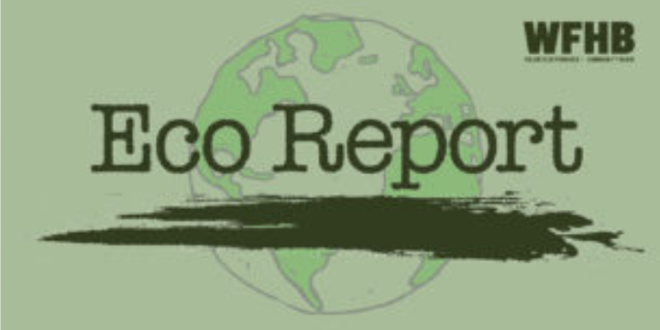Podcast: Play in new window | Download (Duration: 29:51 — 41.1MB)
Subscribe: RSS
| Hello and welcome to Eco-Report. For W-F-H-B, I’m Julianna Dailey. And I am Cynthia Roberts. Later in this half hour, we hear from Marilyn Bauchat of Uplands Network, an aspect of the Hoosier Chapter of the Sierra Club, about their conservation initiatives and upcoming events. |
|
And now for your environmental reports: Inside Clean Energy reports onshore wind energy is working on a comeback in the U.S. market. This is odd to say considering that land-based wind farms are the country’s leading source of renewable power. But it reflects a market in which utility-scale solar and battery storage are growing at much faster rates, and offshore wind is on the cusp of substantial growth. At the same time, onshore wind suffered through a rough 2022. The industry had 8.5 gigawatts of new projects go online last year, which was the lowest number since 2018 and less than half of the record high from 2020. Wind energy manufacturers felt the pain from this downturn, with layoffs and financial losses. Negative press in Indiana has taken a toll on new wind farms. Critics say wind farms are an intrusion into nature in that they have concrete foundations. In addition, their blades can kill high-flying bats and birds — a reality opponents often use to argue against this form of renewable energy. The coal industry is the source of much of the criticism. Actually the pad for a wind turbine is well under an acre, and the landowner typically receives $5,000 per year. Critics also feel no need for honesty. Nationally, wind turbines kill about 200,000 birds and bats per year, well behind collisions with vehicles and buildings. Cats kill 10,000 times as many bird deaths as wind turbines. But the industry is now shifting back into growth mode thanks in part to tax credits under the Inflation Reduction Act, said Ryan Wiser, a senior scientist at Lawrence Berkeley National Laboratory. Some Republican officeholders vow to kill Biden’s Infrastructure Plan -they favor fossil fuels. —Norm Holy |
| Since late April, wildfires have been burning across Canada, blanketing the country and parts of the U.S. in unhealthy and sometimes dangerous smoke, in what Canadian wildfire officials have called the worst wildfire season ever recorded.
In a new study, scientists from the World Weather Attribution Initiative examined the conditions that lead to the record series of wildfires and concluded that they were at least twice as probable due to human-caused climate change. The study, “Climate change more than doubled the likelihood of extreme fire weather conditions in Eastern Canada,” was conducted by scientists from the Netherlands, Canada and the United Kingdom. The area burned by this year’s wildfire season in Canada is bigger than Greece, reported The Guardian. More than 34 million acres have been burned — more than twice the previous record. That area represents approximately 13 billion trees. This year, high temperatures led to the rapid thawing and disappearance of snow during May, particularly in eastern Québec, resulting in unusually early wildfires, said Philippe Gachon, a researcher at the University of Quebec in Montreal, as reported by The Guardian. —Norm Holy |
| The Arctic has been the most affected by global climate change in recent years, resulting in rapid melting of ice and warming, as well as affecting wildlife, particularly the polar bear. Polar bears, the world’s largest land predators, have been designated as “vulnerable” on the Red List. The loss of habitat is the main reason for the decline.
During the third National Arctic Scientific Research Expedition under the auspices of Türkiye’s Polar Research Institute, scientists concluded the sharp decline in Arctic habitat will continue. Recent research indicates that unless carbon emissions are reduced, polar bear populations in many areas may become extinct by the end of this century. —Norm Holy |
| Migration is beginning in Indiana. As fall approaches and daylight diminishes, as leaves begin to change, many species are following their ancient tradition of gathering and heading south. Cerulean warblers leave their Indiana home in August and September and head south to the Andes Mountains for the winter. Other birds, including the Baltimore orioles, scarlet tanagers and indigo buntings are also making their way south through Indiana.
These birds all have one thing in common: they utilize wooded habitats across Indiana to rest, recover and refuel. Now is an excellent time to watch for them in your yard. Migration isn’t limited to birds. We all know about the Monarch butterfly that journey’s thousands of miles to hillsides in Mexico’s fir forests. They love milkweed, so that is one thing you can plant in your yard to help them along their journey. —Julianna Dailey |
| Inside Climate Change reports that rising North Atlantic Ocean temperatures are causing increased numbers of threatened and endangered sea turtles to migrate through Massachusetts waters — heading north in search of food, then back south to their breeding grounds. Their journey is fraught with dangers: fishing gear entanglement, plastic pollution, and habitat loss all threaten their survival, according to numerous environmental and fisheries sources. An additional menace looms large here at this time of year: the summer surge in boating traffic around Cape Cod.
“Vessel strike is a primary cause of sea turtle fatality in our waters,” said Karen Dourdeville, sea turtle research coordinator at Mass Audubon’s Wellfleet Bay Wildlife Sanctuary. Boats frequently collide with sea turtles as they come up for air after diving for food, she said. August and September are peak months for boat strikes here, said Dourdeville, as vessels and migrating sea turtles are both heading south to the Caribbean and Central America. As the oceans warm the food for turtles moves north thus increasing the distance to nesting sites. —Norm Holy |
| And now we turn to Environmental Correspondent Zyro Roze for his interview with Marilyn Bauchat of Sierra Club’s Upland Network on the history of the Hoosier Chapter and the current activities of the conservation organization here in Bloomington and across the state. To learn more about the Hoosier Chapter, go to www.sierraclub.org/indiana.
|
| For Eco-Report, I am Julianna Dailey. And, I am Cynthia Roberts. Are you looking for a way to make a difference on environmental issues?Here at EcoReport we are currently looking for reporters, engineers, and segment producers. Our goal is to report facts on how we’re all affected by global climate disruption and the ongoing assaults on our air, land and water.
We also celebrate ecologists, tree huggers, soil builders and an assortment of champions who actively protect and restore our natural world, particularly those who are active in south central Indiana. All levels of experience and all ages are welcome, and we provide the training you’ll need. W-F-H-B also offers internships. To volunteer for Eco-Report, give us a call at (812) 323-1200, or e-mail us at: [email protected]. |
|
And now for some upcoming events: The MC-IRIS Native Plant Sale will be held this year at the Switchyard Park in Bloomington on Saturday, September 9th, from 9 am to 1 pm. Get there early to get your favorite plants. |
||
| Where are the birds and what can we do? Join the Uplands Network of Hoosier Chapter of Sierra Club Virtual monthly meeting on Monday, September 11th, at 6:30 pm. Dr. Ellen Ketterson, Distinguished Professor of Biology and Co-Director of Midwest Center for Biodiversity, will present data about the decline in the bird population. Register at https://www.sierraclub.org/indiana/upcoming-events-and-outings. | ||
| Take the Kelp Village Hike at Brown County State Park on Friday, September 15th, beginning at 1 pm. Join the naturalist to see this often over-looked history of Brown County State Park before it was a park. Sign up at bit.ly/scv-history2023. | ||
| The Fall Bio Blitz is starting on Friday, September 15th and runs through Monday, September 24th at the Griffy Lake Nature Preserve. Compete to find as many plant and animal species during the week. If you get the most, you win a prize. Register at bloomington.IN.gov/parks. | ||
Join the Sierra Club Hoosier Chapter for a Yellowwood Resource Management Walk on Saturday, September 16th, at 9 am. During this 1-mile easy trail walk, you will learn about forest management techniques such as clear-cuts, controlled burns, select cuts and more. Meet in the Yellowwood parking lot near the forest office. Register with [email protected].
|
 WFHB Bloomington Community Radio
WFHB Bloomington Community Radio




